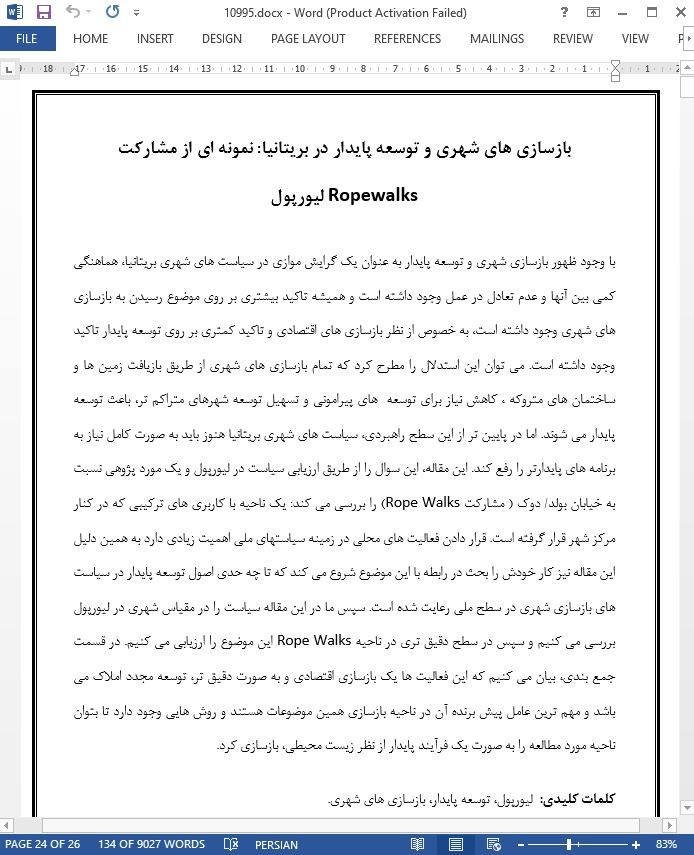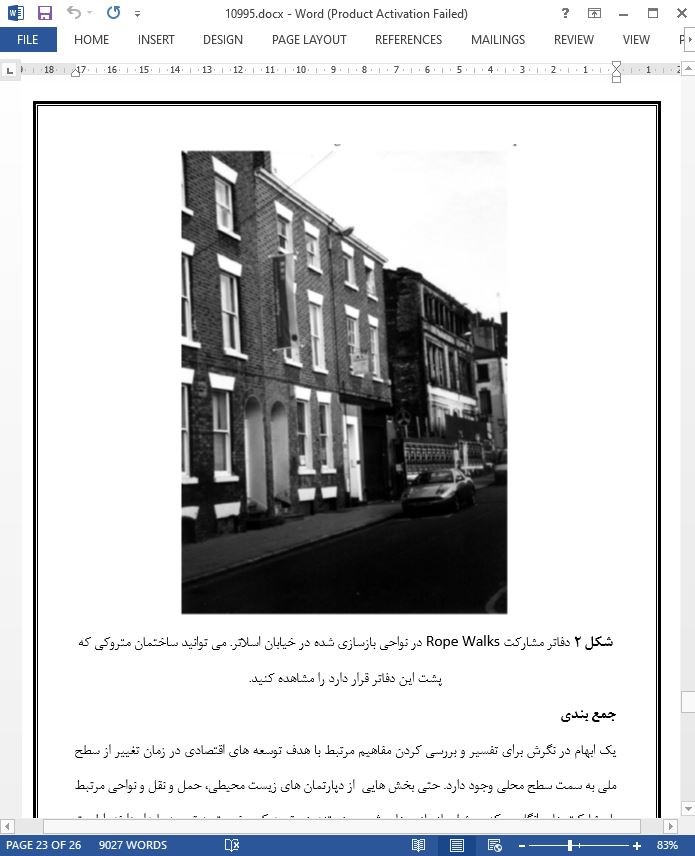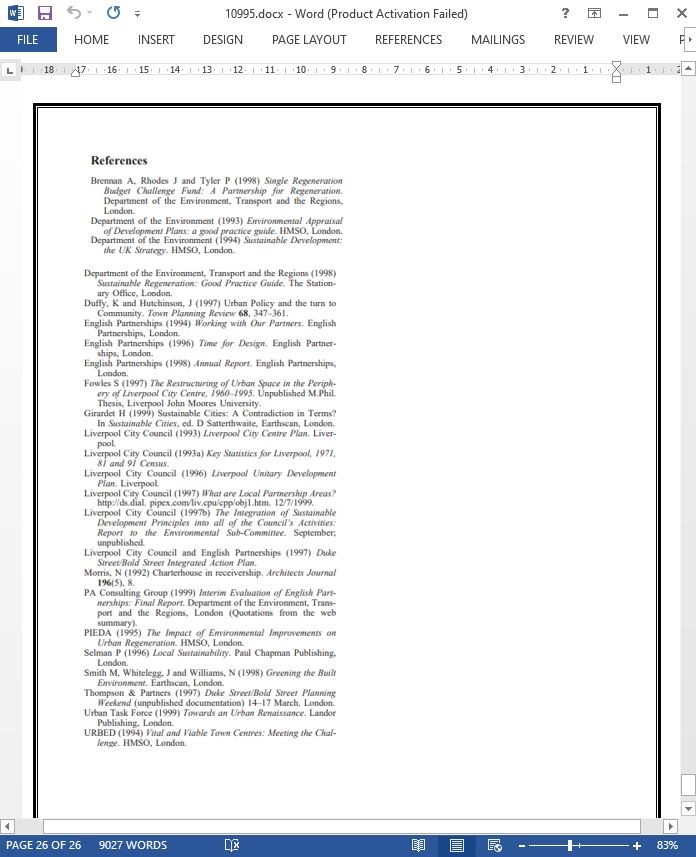
بازسازی های شهری و توسعه پایدار در بریتانیا
با وجود ظهور بازسازی شهری و توسعه پایدار به عنوان یک گرایش موازی در سیاست های شهری بریتانیا، هماهنگی کمی بین آنها و عدم تعادل در عمل وجود داشته است و همیشه تاکید بیشتری بر روی موضوع رسیدن به بازسازی های شهری وجود داشته است، به خصوص از نظر بازسازی های اقتصادی و تاکید کمتری بر روی توسعه پایدار تاکید وجود داشته است. می توان این استدلال را مطرح کرد که تمام بازسازی های شهری از طریق بازیافت زمین ها و ساختمان های متروکه ، کاهش نیاز برای توسعه های پیرامونی و تسهیل توسعه شهرهای متراکم تر، باعث توسعه پایدار می شوند. اما در پایین تر از این سطح راهبردی، سیاست های شهری بریتانیا هنوز باید به صورت کامل نیاز به برنامه های پایدارتر را رفع کند. این مقاله، این سوال را از طریق ارزیابی سیاست در لیورپول و یک مورد پژوهی نسبت به خیابان بولد/ دوک ( مشارکت Rope Walks) را بررسی می کند: یک ناحیه با کاربری های ترکیبی که در کنار مرکز شهر قرار گرفته است. قرار دادن فعالیت های محلی در زمینه سیاستهای ملی اهمیت زیادی دارد به همین دلیل این مقاله نیز کار خودش را بحث در رابطه با این موضوع شروع می کند که تا چه حدی اصول توسعه پایدار در سیاست های بازسازی شهری در سطح ملی رعایت شده است. سپس ما در این مقاله سیاست را در مقیاس شهری در لیورپول بررسی می کنیم و سپس در سطح دقیق تری در ناحیه Rope Walks این موضوع را ارزیابی می کنیم. در قسمت جمع بندی، بیان می کنیم که این فعالیت ها یک بازسازی اقتصادی و به صورت دقیق تر، توسعه مجدد املاک می باشد و مهم ترین عامل پیش برنده آن در ناحیه بازسازی همین موضوعات هستند و روش هایی وجود دارد تا بتوان ناحیه مورد مطالعه را به صورت یک فرآیند پایدار از نظر زیست محیطی، بازسازی کرد.
مقدمه
بازسازی های شهری به یکی از مهم ترین المان های سیاست های شهری در بریتانیا تبدیل شده است. از زمان تصویب قانون نواحی شهری داخلی در سال 1978 ، یک ترکیب از فرآیند های ابتکاری معرفی شده است که با معرفی بودجه بازسازی منفرد و آژانس های بازسازی برای انگلستان، این برنامه ها تقویت شده اند: مشارکت انگلستان. از اوایل دهه 1990، توسعه های پایدار از نظر زیست محیطی به عنوان یک المان مهم از سیاست های شهری خودش را نشان داده است. در توسعه پایدار: استراتژی UK ( 1994)، دولت اهمیت بازسازی های شهری و تاثیر آن بر روی الگوی پایدار از توسعه ها را تایید کرد که از «نواحی از قبل توسعه یافته به موثرترین شکل استفاده کرده و آن ها را به مکانی جذاب تبدیل می کند که برای زندگی و کار مناسب است».
جمع بندی
یک ابهام در نگرش برای تفسیر و بررسی کردن مفاهیم مرتبط با هدف توسعه های اقتصادی در زمان تغییر از سطح ملی به سمت سطح محلی وجود دارد. حتی بخش هایی از دپارتمان های زیست محیطی، حمل و نقل و نواحی مرتبط با مشارکت های انگلیس که مسئول بازسازی های شهری هستند هم تعهد کمی نسبت به توسعه پایدار دارند. اولویت اول برنامه توسعه واحد لیورپول نیز رفع مشکلات اقتصادی شهر می باشد. اگرچه UDP محافظت هایی را برای کیفیت محیط زیست ، منظره شهری ، فضاهای باز و میراث شهر ارائه می کند،اما آن قدر قوی نیست که بتواند یک تاثیر پایداری جهانی را ایجاد کند. در حالی که برنامه LA21 لیورپول به اصول پایداری اعتقاد دارد که شواهدکمی از اجرای آن ها در بازسازی ناحیه Rope Walk دیده می شود.
Despite the emergence of urban regeneration and sustainable development as parallel strands of British urban policy, there has been little co-ordination between them and an imbalance in action with greater emphasis given to achieving urban regeneration, especially economic regeneration, than to sustainability. It can be argued that all urban regeneration contributes to sustainable development through the recycling of derelict land and buildings, reducing demand for peripheral development and facilitating the development of more compact cities. But below this strategic level British urban policy has yet to fully address the requirement for more sustainable development. This paper addresses this question through an examination of policy in Liverpool and a case study of Duke Street/Bold Street (the Rope Walks Partnership): a mixed use area adjoining the city centre. It is important to place local action within the context of national policies and so the paper begins with some discussion of the extent to which the principles of sustainable development are included within national urban regeneration policies before going on to examine policy at the metropolitan scale in Liverpool and then at the more detailed level of the Rope Walks area. The conclusions suggest that it is economic regeneration and more precisely property redevelopment, that is the main driving force regenerating the area and that there is some way to go before the city or the case study area achieve an environmentally sustainable regeneration process.
Introduction
Regeneration has become a major element of British urban policy. Since the passing of the Inner Urban Areas Act in 1978 an array of initiatives has been introduced, culminating in 1993 with the introduction of the Single Regeneration Budget and the regeneration agency for England: English Partnerships. Since the early 1990s, environmentally sustainable development has also emerged as an important element of urban policy. In Sustainable Development: the UK Strategy (1994) the Government recognised the importance of urban regeneration in contributing to a sustainable pattern of development that uses “the already developed areas in the most efficient way, while making them more attractive places in which to live and work” (Department of the Environment, 1994, p. 158).
Conclusions
From the national to the local level there is an ambivalent attitude to sustainable development and a constant attempt to compromise and reinterpret the concept to support the aim of economic development. Even those parts of the Department of the Environment, Transport and the Regions and English Partnerships responsible for urban regeneration policy have only a limited commitment to sustainable development. The first priority of the Liverpool Unitary Development Plan is clearly to tackle the city’s economic problems. Although the UDP offers some protection to local environmental quality, townscape, landscape and built heritage, it is much weaker in making a contribution towards global sustainability. Whilst Liverpool’s LA21 espouses sustainable principles there is little evidence of them being implemented in the regeneration of the Rope Walks area.
مقدمه
پیش زمینه های سیاسی ملی
پیش زمینه سیاسی محلی
منطقه خیابان دوک/ بولد
بررسی کردن پایداری برنامه جامع عملی مشارکت Rope Walks
مشارکت اجتماعی
حمل و نقل
آلودگی
انرژی؛ زباله و منابع
ساختمانها و کاربری اراضی
حیات وحش و فضاهای باز
جمع بندی
Introduction
National policy background
Local policy background
The Duke Street/Bold Street area
Testing the sustainability of the Rope Walks Partnership Integrated Action Plan
Community participation
Economy and work
Transport
Energy; waste and resources
Wildlife and open spaces
Conclusions
- اصل مقاله انگلیسی با فرمت ورد (word) با قابلیت ویرایش
- ترجمه فارسی مقاله با فرمت ورد (word) با قابلیت ویرایش، بدون آرم سایت ای ترجمه
- ترجمه فارسی مقاله با فرمت pdf، بدون آرم سایت ای ترجمه



